Nathan F. Twining facts for kids
Quick facts for kids
Nathan Farragut Twining
|
|
|---|---|

General Nathan F. Twining, c. 1957–60
|
|
| Born | October 11, 1897 Monroe, Wisconsin, U.S. |
| Died | March 29, 1982 (aged 84) Lackland Air Force Base, Texas, U.S. |
| Buried | |
| Allegiance | United States |
| Service/ |
United States Army United States Air Force |
| Years of service | 1915–1947 (Army) 1947–1960 (Air Force) |
| Rank | |
| Commands held | Chairman of the Joint Chiefs of Staff Chief of Staff of the United States Air Force Alaskan Air Command Air Materiel Command Twentieth Air Force Fifteenth Air Force Thirteenth Air Force |
| Battles/wars | Mexican Border Crisis World War I Occupation of the Rhineland World War II |
| Awards | Army Distinguished Service Medal (2) Navy Distinguished Service Medal Legion of Merit (2) Distinguished Flying Cross Bronze Star Medal Air Medal (2) Army Commendation Medal Knight Commander of the Order of the British Empire (United Kingdom) Commander of the Legion of Honour (France) Commander of the National Order of Merit (France) Croix de Guerre (France) Order of the Phoenix (Greece) Order of the Partisan Star with Golden Wreath (Yugoslavia) Gold Cross of Merit with Swords (Poland) Knight Grand Cross of the Military Order of Italy Knight Grand Cordon of the Order of the White Elephant (Thailand) Gugseon Medal of the Order of National Security Merit (South Korea) Taegeuk Cordon of the Order of Military Merit (South Korea) Aviation Cross, First Class (Peru) Medal of Merit (Egypt) |
| Relations | Merrill B. Twining (brother) Nathan C. Twining (uncle) |
Nathan Farragut Twining (born October 11, 1897 – died March 29, 1982) was a highly respected United States Air Force general. He served as the top leader of the Air Force, called the Chief of Staff of the United States Air Force, from 1953 to 1957. After that, he became the third Chairman of the Joint Chiefs of Staff from 1957 to 1960. This was the highest military position in the United States. He was the first Air Force officer to hold this important role. Twining was known as a "mustang" officer because he started his career as a private and rose all the way to a four-star general. He spent 45 years serving his country.
Contents
Early Life and Military Start
Nathan Twining was born to Clarence Walker Twining and Maize (Barber) Twining. His family had a strong history of military service. His brother, Merrill B. Twining, was a general in the United States Marine Corps. Another brother, Robert B. Twining, became a captain in the United States Navy. His uncle, Nathan Crook Twining, was a rear admiral in the Navy.

In 1913, Twining's family moved from Monroe, Wisconsin, to Lake Oswego, Oregon. He finished high school in Portland, Oregon, in 1917. From 1915 to 1917, he was part of the Oregon National Guard, reaching the rank of first sergeant. In 1917, he earned a spot at West Point, a famous military school. He graduated in 1919 after only two years because the program was shortened to train more officers for World War I.
After serving three years in the Army's ground forces, including time in Germany after World War I, Twining joined the United States Army Air Service in 1922. For the next 15 years, he flew fighter planes in places like Texas, Louisiana, and Hawaii. He also went to special schools to improve his military skills.
When World War II began in Europe, he worked in the operations division for the Air Staff. In 1942, he was sent to the South Pacific Area and became the chief of staff for all Allied air forces there.
Leading Air Forces in World War II
In January 1943, Twining was promoted to major general and took command of the Thirteenth Air Force. Later that year, he moved across the world to lead the Fifteenth Air Force. In February 1943, he and 14 others survived a plane crash near the New Hebrides and spent six days on life rafts before being rescued by the U.S. Navy.
When Germany surrendered, Twining was sent back to the Pacific. He commanded the B-29 bombers of the Twentieth Air Force during the final attacks on Japan. However, his time in this role was short because the atomic bombs ended the war. In October 1945, Twining led three B-29s on a record-setting flight from Guam to Washington, D.C., flying 13,167 miles in just over 59 hours.
After the war, he returned to the U.S. and became commander of the Air Materiel Command. In 1947, he took over the Alaskan Air Command.
In September 1947, Lieutenant General Twining wrote a memo about "Flying Discs," which are now known as UFOs. He stated that the strange things military personnel were seeing in the sky were "something real and not visionary or fictitious." This meant he believed these objects were not just imagination or weather events, but real things that needed more study.
Twining was planning to retire as a lieutenant general after three years in Alaska. But when Muir S. Fairchild, the Vice Chief of Staff of the United States Air Force, suddenly passed away, Twining was promoted to full general and took his place.
Leading the Air Force: Chief of Staff
In 1953, General Twining was chosen to be the Chief of Staff of the United States Air Force. During his time in this role, the U.S. strategy for defense became focused on using airpower for "massive retaliation." This meant the Air Force would be the main force to strike back if the country was attacked.
Twining oversaw a huge growth in the Air Force. New jet aircraft like the Boeing B-52 Stratofortress bomber, the Boeing KC-135 Stratotanker refueling plane, and the F-100 Super Sabre fighter jet joined the fleet. He also guided the creation of missile systems for the Air Force. Many people credit Twining with helping the U.S. Air Force become a modern force with advanced equipment, moving past the older planes used in World War II.

General Twining strongly supported the Strategic Air Command (SAC), believing it was the best way to prevent attacks from Communist countries. Because of his support, new SAC bases were built, including an underground command center at Offutt Air Force Base.
Twining also helped calm down disagreements between different military branches, known as "interservice rivalry." These rivalries had grown after World War II. For example, in 1949, the "Revolt of the Admirals" happened when the Navy protested a decision to cancel a new aircraft carrier project. Twining played a big part in easing these tensions.
In 1956, President Eisenhower chose Twining to lead a group of U.S. officers to visit the Soviet Union. This was the first time such an exchange had happened since World War II.
Top Military Leader: Chairman of the Joint Chiefs of Staff

In 1957, President Eisenhower appointed Twining as the Chairman of the Joint Chiefs of Staff. This meant he was the chief military advisor to the President. During his time, Twining guided the U.S. during the early stages of the Space Race. This race became very important after the Soviet Union launched the first satellite, "Sputnik," in 1957.
Twining also supported President Eisenhower's "New Look policy." This policy aimed to make the military stronger by focusing on new science and technology, especially for weapons. The goal was to stop the Soviet Union and its allies from winning the Arms race.
One of Twining's big achievements as Chairman was the launch of the first U.S. liquid-fueled Intercontinental ballistic missiles (ICBMs), the Titan and Atlas Missile, in 1959. He also helped the Strategic Air Command grow much stronger, making it the main force for U.S. nuclear defense.

In 1958, when a rebellion in Iraq worried neighboring Lebanon, General Twining convinced President Eisenhower to send troops to Lebanon. This helped protect the Lebanese government from the uprising. Twining also played a key role during the Second Taiwan Strait Crisis. When China attacked the islands of Quemoy and Matsu, Twining and other military leaders advised President Eisenhower to use force if needed to protect Taiwan. This led to the deployment of U.S. naval forces and aircraft to the area, which helped calm the crisis.
During the Berlin Crisis of 1961 in November 1958, General Twining warned President Eisenhower that a Soviet threat was serious. He advised that the armed forces should be ready for any major crisis.

Twining also helped create new plans for how the U.S. would use nuclear weapons. This led to the development of land-based missiles and Polaris Submarines missiles. These joined bombers to form the "Nuclear Triad," a three-part system for nuclear defense. With Secretary of Defense Thomas S. Gates Jr., Twining helped create the Joint Strategic Planning Staff and the Single Integrated Operational Plan. These plans were very important during the Cold War and continue to be relevant today.
Twining was chosen for a second term as Chairman in 1959. However, due to health issues, he retired from active duty on September 30, 1960.
After retiring, Twining worked as a vice chairman for a publishing company. In 1965, he received the General William E. Mitchell Memorial Award.
General Nathan F. Twining passed away on March 29, 1982, at Lackland Air Force Base in Texas. He was buried at Arlington National Cemetery, a special place for military heroes.
Honors and Awards
General Twining was a highly decorated officer. He earned many awards from the U.S. military and other countries.
- Army Distinguished Service Medal (with an oak leaf cluster, meaning he received it twice)
- Navy Distinguished Service Medal
- Legion of Merit (with an oak leaf cluster, meaning he received it twice)
- Distinguished Flying Cross
- Bronze Star Medal
- Air Medal (with an oak leaf cluster, meaning he received it twice)
- Army Commendation Medal
- Mexican Border Service Medal
- World War I Victory Medal
- Army of Occupation of Germany Medal
- American Defense Service Medal
- American Campaign Medal
- Asiatic-Pacific Campaign Medal (with a silver and four bronze service stars, showing he served in many campaigns)
- European-African-Middle Eastern Campaign Medal (with a silver and bronze service stars)
- World War II Victory Medal
- Army of Occupation Medal
- National Defense Service Medal
He also received honors from other countries, including:
- Knight Commander of the Order of the British Empire (United Kingdom)
- Commander of the Legion of Honour (France)
- Commander of the National Order of Merit (France)
- Croix de Guerre (France)
- Order of the Phoenix (Greece)
- Order of the Partisan Star with Golden Wreath (Yugoslavia)
- Gold Cross of Merit with Swords (Poland)
- Knight Grand Cross of the Military Order of Italy
- Knight Grand Cordon of the Order of the White Elephant (Thailand)
- Gugseon Medal of the Order of National Security Merit (South Korea)
- Taegeuk Cordon of the Order of Military Merit (South Korea)
- Aviation Cross, First Class (Peru)
- Medal of Merit (Egypt)
Other Recognitions
- He was inducted into the National Aviation Hall of Fame in 1996.
- A city park in his birthplace, Monroe, Wisconsin, is named after him.
- An elementary school on the Air Force base in Grand Forks, North Dakota, is also named in his honor.
- A large astronomy observatory in New Mexico is named after him.
Images for kids
-
Chairman of the Joint Chiefs of Staff General Nathan F. Twining with the other members of the Joint Chiefs of Staff at The Pentagon on January 15, 1959.




